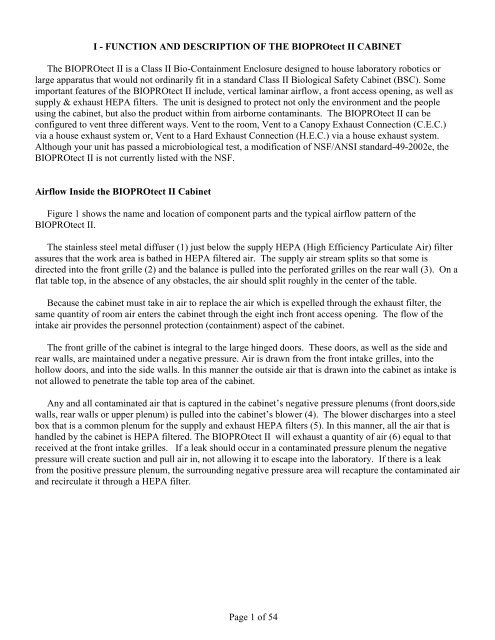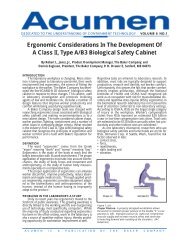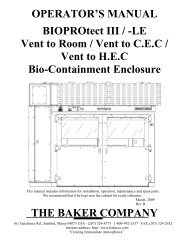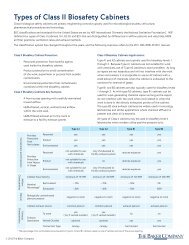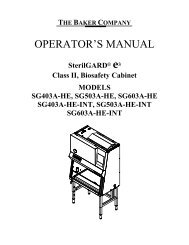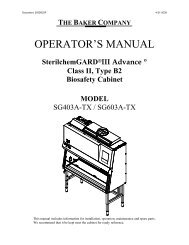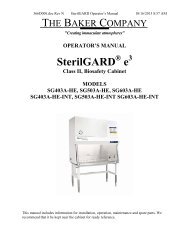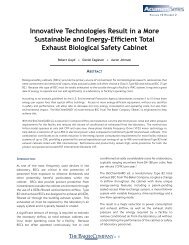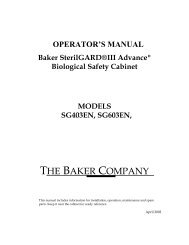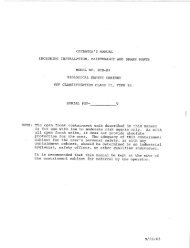OPERATOR'S MANUAL BIOPROtect II Vent to ... - Baker Company
OPERATOR'S MANUAL BIOPROtect II Vent to ... - Baker Company
OPERATOR'S MANUAL BIOPROtect II Vent to ... - Baker Company
Create successful ePaper yourself
Turn your PDF publications into a flip-book with our unique Google optimized e-Paper software.
I - FUNCTION AND DESCRIPTION OF THE <strong>BIOPROtect</strong> <strong>II</strong> CABINETThe <strong>BIOPROtect</strong> <strong>II</strong> is a Class <strong>II</strong> Bio-Containment Enclosure designed <strong>to</strong> house labora<strong>to</strong>ry robotics orlarge apparatus that would not ordinarily fit in a standard Class <strong>II</strong> Biological Safety Cabinet (BSC). Someimportant features of the <strong>BIOPROtect</strong> <strong>II</strong> include, vertical laminar airflow, a front access opening, as well assupply & exhaust HEPA filters. The unit is designed <strong>to</strong> protect not only the environment and the peopleusing the cabinet, but also the product within from airborne contaminants. The <strong>BIOPROtect</strong> <strong>II</strong> can beconfigured <strong>to</strong> vent three different ways. <strong>Vent</strong> <strong>to</strong> the room, <strong>Vent</strong> <strong>to</strong> a Canopy Exhaust Connection (C.E.C.)via a house exhaust system or, <strong>Vent</strong> <strong>to</strong> a Hard Exhaust Connection (H.E.C.) via a house exhaust system.Although your unit has passed a microbiological test, a modification of NSF/ANSI standard-49-2002e, the<strong>BIOPROtect</strong> <strong>II</strong> is not currently listed with the NSF.Airflow Inside the <strong>BIOPROtect</strong> <strong>II</strong> CabinetFigure 1 shows the name and location of component parts and the typical airflow pattern of the<strong>BIOPROtect</strong> <strong>II</strong>.The stainless steel metal diffuser (1) just below the supply HEPA (High Efficiency Particulate Air) filterassures that the work area is bathed in HEPA filtered air. The supply air stream splits so that some isdirected in<strong>to</strong> the front grille (2) and the balance is pulled in<strong>to</strong> the perforated grilles on the rear wall (3). On aflat table <strong>to</strong>p, in the absence of any obstacles, the air should split roughly in the center of the table.Because the cabinet must take in air <strong>to</strong> replace the air which is expelled through the exhaust filter, thesame quantity of room air enters the cabinet through the eight inch front access opening. The flow of theintake air provides the personnel protection (containment) aspect of the cabinet.The front grille of the cabinet is integral <strong>to</strong> the large hinged doors. These doors, as well as the side andrear walls, are maintained under a negative pressure. Air is drawn from the front intake grilles, in<strong>to</strong> thehollow doors, and in<strong>to</strong> the side walls. In this manner the outside air that is drawn in<strong>to</strong> the cabinet as intake isnot allowed <strong>to</strong> penetrate the table <strong>to</strong>p area of the cabinet.Any and all contaminated air that is captured in the cabinet’s negative pressure plenums (front doors,sidewalls, rear walls or upper plenum) is pulled in<strong>to</strong> the cabinet’s blower (4). The blower discharges in<strong>to</strong> a steelbox that is a common plenum for the supply and exhaust HEPA filters (5). In this manner, all the air that ishandled by the cabinet is HEPA filtered. The <strong>BIOPROtect</strong> <strong>II</strong> will exhaust a quantity of air (6) equal <strong>to</strong> thatreceived at the front intake grilles. If a leak should occur in a contaminated pressure plenum the negativepressure will create suction and pull air in, not allowing it <strong>to</strong> escape in<strong>to</strong> the labora<strong>to</strong>ry. If there is a leakfrom the positive pressure plenum, the surrounding negative pressure area will recapture the contaminated airand recirculate it through a HEPA filter.Page 1 of 54


